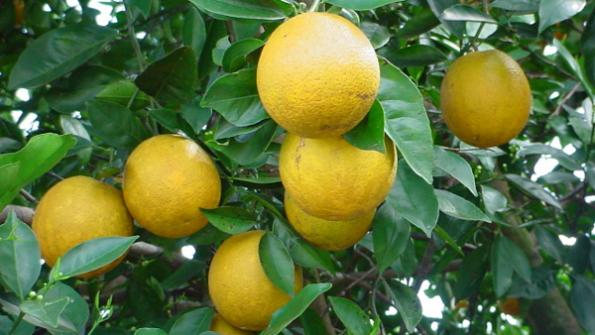
The Asian psyllid, a moth that delivers the citrus greening disease to citrus trees, has been present in the Texas Rio Grande Valley for a number of years.A comprehensive psyllid control program initiated three years ago has helped to control population levels and may have been instrumental in delaying the movement of the disease to the Texas Valley. Texas Agriculture Commissioner Todd Staples addressed growers and nursery owners in the Rio Grande Valley Tuesday on the latest developments on the discovery of the state’s first confirmed case of the disease.

Calling the fight against citrus greening disease a cooperative effort, Texas Agriculture Commissioner Todd Staples addressed growers and nursery owners in the Rio Grande Valley Tuesday commending their preventative efforts to control Asian psyllid populations in recent years and praising rapid local, state and federal response to the discovery of the state’s first confirmed case of the disease.
While the disease decimated the Florida citrus industry in 2006 causing an estimated $3.6 billion in losses and forced 6,600 workers out of a job, Texas has avoided a case of the disease until this month when a single orange tree was discovered with the disease in a commercial grove near San Juan.
Citrus greening has also been detected in Georgia, South Carolina and Louisiana.
While the Asian psyllid, a moth that delivers the disease to citrus trees, has been present in the Valley for a number of years, a comprehensive psyllid control program initiated three years ago has helped to control population levels and may have been instrumental in delaying the movement of the disease to the Texas Valley.
“The detection of this plant disease in Texas has long been expected and, unfortunately, its spread is unavoidable,” Commissioner Staples said. “While citrus greening poses no threat to human health, it has caused serious economic damage to the citrus industries in Florida, Africa, Asia and South America. Our Texas citrus industry generates $140 million for our state’s economy each year, and today we are partnering with our growers and other experts to ensure our citrus groves continue to be healthy and productive.”
Rapid Response
Within hours of detection of the disease in Texas, TDA implemented an emergency quarantine of plants in the area, prohibiting the movement of citrus stock outside a five-mile quarantine zone surrounding the commercial grove where the infected tree was found. (See http://southwestfarmpress.com/orchard-crops/tda-extends-citrus-quarantine-schedules-meeting-valley-growers.)
TDA convened a science panel of experts from industry, academia and government to advise and guide the mitigation measures implemented to respond to the detection and to begin a comprehensive survey of trees within the quarantine zone to determine other instances of infection.
While the preliminary survey indicates more than one tree on the same commercial grove may suffer from the disease, Citrus Mutual President Ray Prewett says the survey results are preliminary and says after Tuesday’s gathering, growers in the Valley “feel a little better” about being prepared for what some have called “an inevitable development.”
“It is too early to determine the extent of the problem, not until the survey is complete and all the results have been evaluated. There are 138 commercial citrus groves within the five-mile quarantine zone spread across some 900 acres. A scientific panel will convene Friday to evaluate the samples taken from this area, and we will have a better idea of where we go from there,” Prewett said.
“I do want to say that the grower that owns the grove where citrus greening was discovered has been extremely active in the local psyllid eradication program and has done everything that could be done to prevent citrus greening from getting established in the Valley. This is true of almost all of the many commercial growers and nurserymen in South Texas,” he added.
According to industry experts and researchers, of most concern are the number of citrus trees located on private property and in residential backyards where organized control programs couldn't reach.
“Some testing of these trees is taking place now, but there is a large population of citrus not grown on commercial sites that are of some concern,” Prewett adds. “But commercial growers and the nurseries in the Valley are willing to do whatever it takes to control this problem and even now our psyllid control program and early detection efforts continue all across the region.”
TDA officials warn that extending the emergency quarantine is most likely inevitable as a safeguard against the movement of the disease and are suggesting the quarantine zone will probably be expanded as well as a precaution.
“We know the impact this disease has had in Florida,” said citrus grower Becky Bonham. “However, in Florida the disease was widespread before they realized the situation. Today we have reason to hope that in Texas the disease was detected before it became widespread.”
Citrus greening is a bacterial disease that attacks the vascular system of plants. It does not affect the consumption quality of the fruit itself, but once infected, there is no known cure for a tree with citrus greening disease. In areas of the world where citrus greening is endemic, citrus trees decline and die within a few years.
About the Author(s)
You May Also Like





